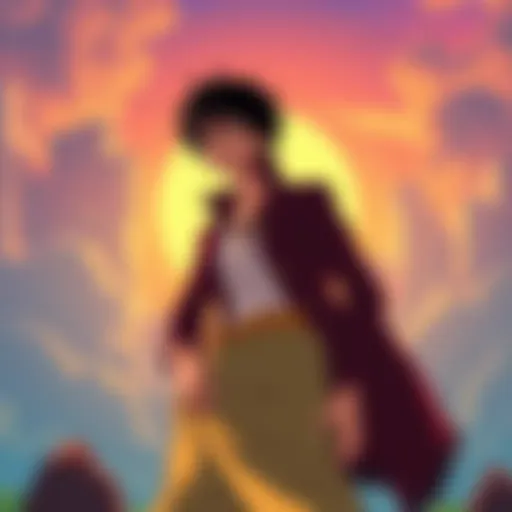Comprehensive List of Demon Slayer Episodes: A Thorough Exploration
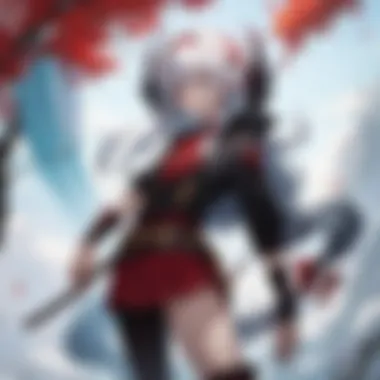

Intro
Demon Slayer, or Kimetsu no Yaiba, emerged as a powerful force in the anime landscape. Its gripping story, remarkable artistry, and deep emotional resonance captivated both casual viewers and devoted fans. To truly engage with this series, it is vital to understand the episodes that build its narrative and thematic structure. This exploration offers a meticulous breakdown of each episode, enhancing the viewing experience through context and analysis.
As we delve into the details, the aim is to facilitate a nuanced appreciation of Demon Slayer, allowing audiences to connect with its wide-ranging cultural implications.
Series Overview
Synopsis and Premise
The story begins in Taisho-era Japan, where Tanjiro Kamado, a kind-hearted boy, lives a peaceful life with his family as charcoal sellers. However, tragedy strikes when demons descend upon his home, annihilating his family and leaving his sister Nezuko transformed into a demon. Stricken by grief, Tanjiro vows to hunt down the demon who devastated his family and to find a way to cure Nezuko. This foundational plot establishes a classic tale of vengeance and redemption, layered with rich emotional depth and moral dilemmas.
Notable Characters
Demon Slayer features a cast that exemplifies various themes central to the narrative. Among them:
- Tanjiro Kamado: The resilient protagonist whose compassion defines his interactions.
- Nezuko Kamado: Tanjiro's sister, representing the struggle against demon existence while retaining her humanity.
- Zenitsu Agatsuma: An unlikely ally, whose comedic fear masks great skill in battle.
- Inosuke Hashibira: A boar-masked warrior embodying raw instinct and physical prowess.
Each character contributes uniquely to the overarching story, enriching the narrative's exploration of human emotions, strength, and connection.
Themes and Motifs
Major Themes Explored
Demon Slayer is replete with significant themes, including:
- Family and Sacrifice: The bond between siblings drives much of the plot, highlighting the lengths to which Tanjiro will go to protect Nezuko.
- Courage and Growth: Characters face internal and external fears, leading to profound transformations.
- Good vs. Evil: The series presents a complex view of morality, blurring the lines between hero and villain.
Symbolism in Storytelling
Symbolism plays a key role in character and plot development. The use of sunlight as a means to counter the demons emphasizes hope and purity. Furthermore, Nezuko’s struggle to balance her demon instincts with her human memories reflects the duality of existence.
Artistic Style and Animation
Visual Aesthetics and Design
The stunning visual presentation is a hallmark of Demon Slayer. With vivid colors and meticulous attention to detail, each frame comes alive. The character designs reflect their personalities and arcs, further engaging viewers. The fluid movement in battle scenes showcases the harmony between animation and choreography, making action sequences particularly compelling.
Animation Techniques and Trends
Demon Slayer employs a mix of traditional animation with modern techniques, enhancing both visual appeal and storytelling. Notable is the use of CGI during combat, which allows for vibrant and dynamic sequences. This integration sets a new standard in anime, influencing trends within the industry.
"Demon Slayer's artistry is a blend of traditional storytelling and cutting-edge animation, resulting in something truly special."
This exploration of Demon Slayer aims to deepen understanding and foster appreciation of the series. Through an analysis of episodes alongside a discussion of themes and character development, fans and newcomers can engage with the material while grasping its cultural depth. This compilation is important for anyone seeking to enrich their viewing experience.
Overview of Demon Slayer
The Overview of Demon Slayer serves as a vital introduction, establishing the groundwork for the entire article. This section highlights significant aspects of the series, its storyline, and its characters. Understanding these foundational elements enhances the reader's ability to appreciate the intricate details explored in subsequent sections.
Demon Slayer has emerged as a defining title in contemporary anime culture. Its blend of breathtaking animation, compelling storytelling, and deep emotional themes has garnered a massive global fan base.
By delving into the Overview of Demon Slayer, readers can grasp the essence of the series, which is crucial for appreciating the detailed episode breakdowns that follow. Key components such as plot arcs, characterization, and thematic richness play an integral role in understanding why this series resonates with so many. The significance of this overview can be summarized in several points:
- Establishes context for the thematic analysis later in the article.
- Highlights essential characters and their roles in the narrative.
- Sets the stage for discussions about cultural impact and critical reception.
In short, this section provides a succinct yet thorough introduction, orienting the reader before they explore deeper into the individual episodes and themes.
Season One Episodes
Season One of Demon Slayer serves as the foundational pillar for understanding the entire series. It presents not only the introduction of key characters but also establishes the overarching themes and narrative arcs that will evolve throughout subsequent episodes. The significance of this season lies in its meticulous world-building and character development, which are crucial for both new and returning viewers to grasp the emotional cores of the story.
Episode Breakdown
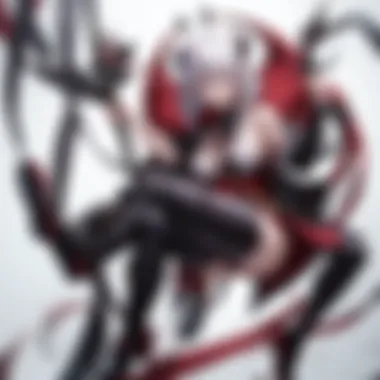

The first season consists of twenty-six episodes, each contributing uniquely to character formation and plot advancement. The pacing, animation quality, and soundtrack are pivotal in creating an immersive experience.
- Episode 1: Cruelty - Introduces Tanjiro Kamado and sets the stage for his journey.
- Episode 2: Trainer - Tanjiro begins training under Sakonji Urokodaki, demonstrating the early signs of his determination.
- Episode 3: Sabito and Makomo - Focus on Tanjiro's challenges and his interactions with Urokodaki's previous students, highlighting his growth.
- Episode 12: Tsuguko, Kanao Tsuyuri - Marks pivotal developments as Tanjiro meets new allies and showcases the evolution of his skills in battle.
Each episode is crafted to highlight both the external conflicts and the internal struggles of the characters. This balance is vital for engaging the audience and fostering emotional connections.
Significant Plot Developments
Key plot developments during Season One lay the groundwork for the characters’ motivations and future encounters.
- Family Tragedy: The inciting incident of the series is the brutal slaughter of Tanjiro’s family and Nezuko’s transformation into a demon. This tragedy propels Tanjiro's quest for vengeance and redemption.
- Demon Slayer Corps: Tanjiro’s initiation into the Demon Slayer Corps serves as a crucial plot point, linking him to a larger organization that fights against demons. This affiliation leads to significant character encounters and challenges.
- Power Dynamics: As Tanjiro faces various demons, the audience gains insight into the hierarchy of demon powers. Characters like Muzan Kibutsuji are introduced, hinting at major conflicts to come.
Overall, Season One builds a rich narrative landscape. It establishes a framework where themes of resilience, family bonds, and the struggle against evil are meticulously explored. As viewers progress through this season, they grasp the depth of Demon Slayer, setting the stage for the complex narratives that follow.
Season Two Overview
The Season Two Overview of Demon Slayer is a pivotal discussion in understanding the series' evolution. After the monumental success of the first season and the Demon Slayer: Mugen Train film, the second season expands on fundamental plotlines and character arcs. It also introduces new elements that capture the audience's attention and deepen their emotional investment in the story.
In this season, the Mugen Train Arc not only continues the narrative but also reinforces the themes of sacrifice, friendship, and perseverance. By analyzing this segment, viewers gain insight into how the narrative builds upon its predecessors, setting the stage for character growth and new challenges. The importance of Season Two lies in its ability to connect with both the established viewers who followed the journey closely and those who are introduced through the film.
Additionally, exploring Season Two showcases how the series adapts various storytelling techniques such as pacing, character interactions, and emotional depth. These elements ensure that the audience remains engaged while offering a fresh perspective on familiar themes.
Mugen Train Arc Episodes
The Mugen Train Arc episodes serve as a vital component of the overall narrative structure. This arc recounts the story of Tanjiro, Nezuko, Zenitsu, and Inosuke as theyboard a train plagued by demonic forces. Each episode reveals not only intense battles but also profound character revelations, particularly concerning Rengoku, the Flame Hashira.
As viewers progress through this arc, they experience:
- High-stakes confrontations: The battles against the Lower Moons illustrate the relentless challenges the Demon Slayers face.
- Character backstories: The inclusion of Rengoku's past helps viewers understand his motivations and ideals, enhancing emotional investment.
- Themes of unity: The collaboration between the characters underlines the importance of teamwork in overcoming adversities.
Through this arc, the series not only deepens its world-building but also explores themes of camaraderie, courage, and accountability, thus enriching the viewing experience.
Impact of the Feature Film
The impact of Demon Slayer: Mugen Train cannot be overstated. It has set numerous box office records and has become a cultural phenomenon. The film's success established a precedent for anime adaptations and demonstrated that anime can achieve significant commercial success beyond its traditional audience.
In terms of storytelling, the film effectively transitions to the series' narrative style, maintaining the same animation quality and emotional intensity. The positive reception of the film ultimately led to heightened anticipation for Season Two.
Moreover, the film introduced several critical concepts, such as the dynamic between dreams and reality, which play an essential role in the overall narrative. The reactions from fans highlighted a collective appreciation for the emotional depth and artistry, marking a turning point for the series within the industry.
"Demon Slayer not only entertains but also resonates on various emotional levels, achieving remarkable success through its compelling storylines and character arcs."
In summary, the Mugen Train arc and the film together enhance the narrative tapestry of Demon Slayer, ensuring that the series continues to captivate its audience while addressing intricate themes and character developments.
Season Three Episodes
Season three of Demon Slayer brings forth a critical development in the narrative, introducing the Hashira Training Arc, where characters undergo rigorous training to face the increasing threats posed by demons. This season's episodes are significant in understanding character growth, their relationships, and the overarching themes of ambition and perseverance. For fans and newcomers alike, verifying this season helps contextualize key motivations within the series. It blends character arcs with deeper storytelling, setting the stage for future conflicts.
Overview of the Hashira Training Arc
The Hashira Training Arc is pivotal for several reasons. It illustrates the intense preparation that the Demon Slayer Corps members must undergo. This training regime is orchestrated by the Hashira, who are elite demon slayers with exceptional skills and powers. By immersing themselves in this training, Tanjiro Kamado, Zenitsu Agatsuma, and Inosuke Hashibira refine their abilities while tackling their personal weaknesses.
Each episode serves as a progression through various challenges that test their physical and emotional limits. The camaraderie that develops in this arc shows how teamwork is integral to their success.
As viewers watch, they grasp important concepts such as:
- Physical endurance: Characters push their bodies to the limits.
- Understanding of strengths and weaknesses: This arc highlights their capacity for self-reflection.
- Dynamic between characters: How time spent training fosters deeper connections.
This arc also lays the groundwork for understanding the skills and powers of Hashira themselves going forward. The interactions often reveal personality traits that were less pronounced in previous seasons.
Character Developments
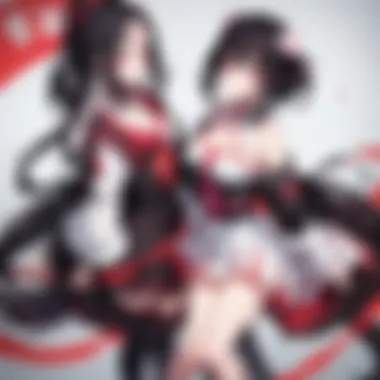

In this season, character development takes center stage. Each protagonist experiences significant growth that deepens their individual arcs.
- Tanjiro Kamado: Tanjiro continues to embody resilience and empathy, which shape his fighting style and interactions. His understanding of demon origins grows, leading him to question the nature of humanity in his enemies.
- Zenitsu Agatsuma: Zenitsu faces his fear of inadequacy and works to improve himself. His character grows, showing that bravery often involves confronting one's insecurities.
- Inosuke Hashibira: Inosuke's development is visible through his evolving dynamic with the group. He learns to appreciate teamwork, something he once rejected.
These character arcs intertwine to build a richer narrative, offering viewers a deeper understanding of each character's motivations and struggles. Through their training challenges, the emotional stakes rise, leaving viewers anxiously anticipating the outcomes in battles yet to come.
By witnessing these developments, viewers not only appreciate the characters' physical prowess but also their considerable emotional journeys.
Overall, season three is crucial for building suspense and expanding the scope of Demon Slayer, reinforcing why the series has garnered such a dedicated fan base.
Character Arcs and Progression
Understanding character arcs and progression is essential when exploring any narrative, particularly in a series like Demon Slayer. The evolution of characters significantly impacts the audience's emotional connection, driving the story forward. Each main character brings unique experiences and motivations that influence their decisions and interactions. In this section, we will examine the growth of four primary characters: Tanjiro Kamado, Nezuko Kamado, Zenitsu Agatsuma, and Inosuke Hashibira. This detailed analysis not only enhances our comprehension of the series but also illustrates how character development aligns with the overarching themes.
Tanjiro Kamado
Tanjiro Kamado is the protagonist, and his character arc is central to the series. As a kind-hearted young boy, he begins his journey with the tragic loss of his family due to demons. This motivates him to become a demon slayer, seeking vengeance and a cure for his sister Nezuko. Throughout the series, Tanjiro’s growth emerges from his relentless determination and strong moral compass.
He consistently shows compassion, even towards demons. This duality highlights his struggle between vengeance and empathy. Tanjiro’s character progression embodies themes of perseverance and accountability. He learns new skills and techniques, ultimately becoming a competent fighter, but it is his emotional maturity that captivates the audience.
Nezuko Kamado
Nezuko Kamado serves as both a victim and a source of strength. Transformed into a demon, her journey revolves around resisting her violent instincts while protecting her brother. Nezuko’s character arc showcases her loyalty and the bond with Tanjiro. Despite her silent nature, her development is evident through her evolving powers and strategies during battles.
The changes in her demeanor, especially when she displays protective instincts for Tanjiro or other humans, illustrate her internal struggle. Nezuko's growth contributes to the themes of familial love and the battle against one’s nature. Her presence challenges the notion of demons as mere monsters, revealing a more complex narrative.
Zenitsu Agatsuma
Zenitsu Agatsuma begins as a timid character, consumed by fear. His progress throughout the series is stark and noteworthy. Although often portrayed as cowardly, Zenitsu’s personality evolves as he learns to embrace his role as a demon slayer. His ability to fall asleep and unleash tremendous strength while unconscious symbolizes the potential that lies beneath his surface.
This duality in Zenitsu's character reflects broader themes of courage and self-discovery. As he encounters various situations, he learns to face his fears, growing remarkably from his initial state of anxiety to a braver, more capable fighter. His gradual transformation illustrates that courage can manifest in different forms.
Inosuke Hashibira
Inosuke Hashibira represents a contrasting personality to Tanjiro and Zenitsu. With a feral demeanor and unapologetic pride, he initially approaches battles with reckless abandon. His journey revolves around discovering his self-worth and understanding camaraderie.
Despite his rough exterior, Inosuke showcases a deep desire for acceptance. His interaction with Tanjiro and Zenitsu encourages him to grow as a person, moving away from isolation. Inosuke’s character arc emphasizes themes of friendship and identity. His wild nature is not only a barrier but also a catalyst for growth as he learns to adapt and collaborate.
"Character arcs are vital in Demon Slayer as they reflect not just individual growth but also the narrative's emotional core."
Each of these character arcs provides a rich exploration into the human experience, even amidst a supernatural backdrop. Through their developments, Demon Slayer articulates poignant messages about family, bravery, and the constant struggle between good and evil.
Cultural Impact of Demon Slayer
The cultural impact of Demon Slayer extends far beyond its initial airing. This anime series has redefined several elements in its genre and has set new standards for storytelling and animation quality. As an exploration of this impact, one can examine its global reception and accolades, along with its contributions to the anime and manga culture.
Reception and Awards
Demon Slayer has garnered significant acclaim since its debut. It achieved unprecedented viewership numbers and quickly became a cornerstone in modern anime. The series has received numerous awards, indicating its excellence in various categories.
Notably, it won the Tokyo Anime Award Festival, and at the 2020 Crunchyroll Anime Awards, it took home several accolades, including Anime of the Year.
The critical reception also highlights the show’s unique storytelling and character development, which resonate with viewers worldwide.
"Demon Slayer exemplifies how narratives can blend action with emotional depth, appealing to a broad audience."
Fans often cite specific episodes that left a lasting impression on them, showcasing the emotional weight behind the characters and their struggles.
Influence on Anime and Manga Culture
The influence of Demon Slayer on both anime and manga culture is substantial. Its success has paved the way for new works that aspire to achieve similar acclaim. This series ignited renewed interest in the shonen genre, prompting studios to prioritize quality animation and deeply layered narratives.
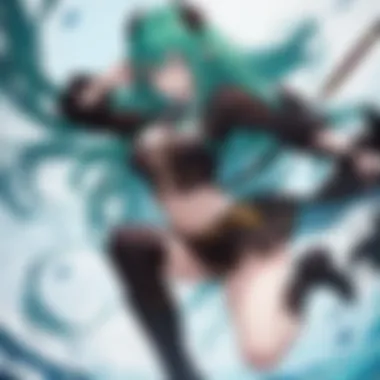

Key elements contributing to its influence include:
- Animation Quality: The use of digital effects and traditional animation techniques has set a new benchmark for visual storytelling.
- Character Representation: Diverse character designs and strong female leads have encouraged other series to explore complex characters.
- Merchandising Boom: The brand has led to an explosion of merchandise, from figurines to clothing, fostering a new wave of fandom engagement.
The combination of these factors solidified Demon Slayer as a landmark title in the anime community, establishing it as a reference point for upcoming artists and creators.
Comparative Analysis
The comparative analysis section seeks to situate Demon Slayer within the broader landscape of anime, specifically focusing on its relationship with other popular shonen titles. This discourse is essential for understanding how Demon Slayer not only fits into the genre, but also carves its distinct niche within it. By contrasting elements such as narrative style, character development, and thematic depth, readers can appreciate the unique qualities that set this series apart from its contemporaries.
In this context, evaluating Demon Slayer against other shonen series allows for a deeper comprehension of its narrative techniques and audience reception. It illuminates how the series employs its artistic choices to forge emotional connections with viewers. Furthermore, such an analysis provides insight into the genre's evolution, highlighting shifts in storytelling practices, character archetypes, and thematic pursuits.
Demon Slayer versus Other Shonen Titles
When considering Demon Slayer alongside other prominent shonen titles like Naruto, My Hero Academia, and One Piece, several distinctions emerge.
- Narrative Focus: While many shonen series tend to emphasize action and adventure, Demon Slayer intertwines a poignant exploration of familial bonds and trauma. This narrative depth resonates with audiences, allowing for a layered viewing experience.
- Character Development: Demon Slayer excels in crafting characters who evolve organically in response to their experiences. Unlike some series that may rely on archetypes, Tanjiro and Nezuko exemplify growth and moral complexity, which refreshes the character dynamics in the genre.
- Visual Aesthetics: The animation quality of Demon Slayer, particularly through Ufotable’s production, significantly amplifies its storytelling. The series employs innovative techniques in action sequences and emotional moments that elevate its visual narrative, making it visually distinct.
- Thematic Exploration: Many shonen series focus on themes of ambition and rivalry. In contrast, Demon Slayer emphasizes themes of sacrifice, the weight of regret, and the pursuit of redemption. This thematic shift enriches its narrative landscape and challenges conventions often seen in shonen.
Unique Aspects of Storytelling
One can argue that the storytelling in Demon Slayer is exceptional due to its integration of multiple narrative techniques that enhance character attachment and emotional engagement. Below are some unique aspects that define its storytelling prowess:
- Layered Flashbacks: The use of flashbacks in Demon Slayer is poignant and carefully placed, revealing character backstories that deepen viewers' understanding of their motivations and fears.
- Pacing and Timing: The series strikes a balance between action and slower, introspective moments, allowing viewers to absorb character challenges and emotional shifts. This rhythm cultivates anticipation and grants weight to pivotal scenes.
- Symbolism and Visual Metaphors: Demon Slayer employs various symbols, such as the Sun and the Moon, to represent the dual nature of its characters and the cyclical nature of life and death, creating a rich tapestry of meaning throughout the series.
- Cultural Richness: The incorporation of Japanese mythology and historical elements enriches the narrative, providing context that resonates with both native and international audiences. This depth invites viewers to explore connections between the story and cultural narratives.
In summary, the comparative analysis of Demon Slayer against other shonen titles reveals its unique contributions to the genre. It not only establishes benchmarks for animation quality and character depth but also challenges traditional narrative structures, offering a refreshing take on storytelling. Through this analysis, fans can gain greater appreciation for what makes Demon Slayer an exemplary work in contemporary anime culture.
Exploring Themes in Detail
The exploration of themes in Demon Slayer is a fundamental aspect of understanding the series and its wide-reaching impact. This section delves into key thematic elements that not only shape the narrative but also resonate with the audience. By examining these themes, readers gain insight into character motivations and moral quandaries, shedding light on what makes Demon Slayer a profound storytelling experience.
The Concept of Fear and Courage
Fear and courage are pivotal themes woven throughout the fabric of Demon Slayer. Characters often confront their deepest fears, which serves as a catalyst for their development. Tanjiro Kamado embodies courage in the face of overwhelming odds. His unwavering resolve to protect his sister Nezuko and avenge his family drives much of the story. This theme highlights a crucial point: courage is not the absence of fear, but rather the ability to act despite it.
In numerous instances, other characters grapple with their fears, representing various facets of human emotion. For example, Zenitsu Agatsuma's comical yet poignant fear of fighting contrasts sharply with moments of bravery when he transcends his insecurities. This juxtaposition enriches the narrative, providing depth to character arcs as they navigate through their existential struggles.
"Courage does not always roar. Sometimes it is the quiet voice at the end of the day saying, 'I will try again tomorrow.'"
This duality of fear and courage encourages viewers to reflect on their own lives and challenges, prompting a deeper connection to the series. Furthermore, it serves to humanize characters, making their victories and defeats resonate more profoundly.
Family and Sacrifice
Family and sacrifice emerge as emotive themes that are central to Demon Slayer. The series portrays family bonds with intensity, particularly through Tanjiro’s relationship with Nezuko. Their journey embodies the lengths one will go to protect loved ones. Tanjiro's commitment to his sister, despite her transformation, exemplifies unconditional love—a theme that is both comforting and heartbreaking.
Sacrifice is intricately linked to family dynamics in the series. Characters often face choices that demand personal sacrifice for the sake of others. These moments reveal larger truths about loyalty and the necessity of sometimes letting go for the greater good. For instance, several Hashira, the elite demon slayers, have faced tragedies that push them to prioritize the well-being of humanity over their lives. This is poignantly emphasized in the Mugen Train arc, where the emotional weight of sacrifice is made evident.
Understanding these themes enriches the viewing experience, as they trigger powerful emotional responses. They also encourage reflection on personal relationships and societal values, grounding the fantasy narrative in real-world experiences that resonate with audiences. In this way, Demon Slayer offers not merely a tale of adventure but a contemplation of life, loss, and the enduring spirit of humanity.
Future of the Series
The future of the Demon Slayer series captures significant interest among fans and analysts alike. This section addresses the key elements that will shape its continuing evolution, focusing on upcoming episodes and character developments. Understanding this future trajectory offers viewers a roadmap for engagement with the story while providing a framework for deeper analysis. As Demon Slayer has already established a substantial following, the anticipation surrounding its next installments presents unique opportunities for both storytelling and fan involvement.
Upcoming Episodes and Events
The announcement of new episodes typically catalyzes excitement within the community. Fans are eager to witness how the narrative will expand. The upcoming episodes will likely continue from previous arcs, and this momentum creates high expectations. With the manga concluding, the anime adaptation must effectively encapsulate its essence.
Key aspects to consider include:
- Release schedules: Knowing when to expect new content can help viewers track developments.
- Arc transitions: Significant shifts in the story dynamics will occur, which may affect character arcs.
- Animation quality: Produced by Ufotable, the animation quality plays a crucial role in viewer experience, setting a precedent for upcoming projects.
"The continuation of Demon Slayer promises to explore untapped narratives and deepen the emotional resonance of its characters."
Speculations on Character Developments
As the series progresses, character developments evolve and grow more intricate. Following established patterns in storytelling, fans can predict possible arcs for main characters. Tanjiro, Nezuko, and others have experienced substantial growth, setting the stage for further transformations and conflicts.
- Tanjiro Kamado may confront moral dilemmas that challenge his resolve and beliefs. His evolution could emphasize themes of determination and sacrifice.
- Nezuko Kamado is likely to face trials that test her humanity further, possibly bringing forth unresolved tensions between her demon instincts and human emotions.
- New characters introduced may also play significant roles, affecting relationships with the existing cast.



